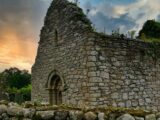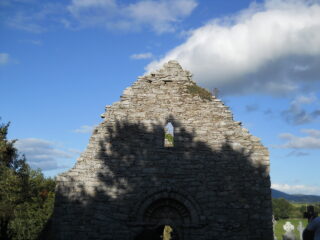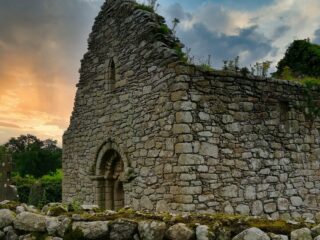Fógra
WARNING: It should be noted that these sites are unguided and a level of care and caution should be maintained during all stages of your visit. The Office Of Public Works (OPW) will not be held responsible for any damages, injuries, or losses that occur
Ullard Church
Ullard Church sits on the site of an early monastery founded by St. Fiacre (also spelt St. Fiachra) in the 6th century. Ullard Church, built by the 12th century, is a nave and choir church. Entry to the interior is via the Romanesque doorway in the west gable. This rounded doorway has three orders with a tympanum, surrounded by a hood-moulding with its bosses decorated and terminates in two large beast-heads. Above the doorway, in the apex of the gable is a carved stone with two figures believed to be St. Moling and St. Fiacre. The nave is lit by two round-headed windows, narrow on the outside and wider on the interior. The choir arch shows that it was rebuilt, with the upper arch having fallen during a fire. The original arch shows floral and chevron decorations on the moulding while the rebuild is plain. Even the rebuilt arch shows the effect of having been burned.
It is noted in history that Ullard Church of St. Fiacre, and Mullenakill Church of St. Moling were repeatedly attacked and burned. The Vikings, from 824 up to 951, were frequently plundering and burning the area and later the native Irish were attacking these areas. The sedilla and piscine are found housed within a semi-circular-arch, in the choir, but the altar is missing. The surviving window is a two-light ogee-headed window, carved from cut limestone. An underground vaulted chamber at the east end of the choir is the burial crypt for the Eustace family of Ballamurrough House. A stone staircase from the choir lead up through the thickness of the wall, going from a straight staircase to a spiral staircase. The belfry once housed the Sanctus bell. In the surrounding graveyard is a High Cross, found to be fragmented into three pieces, now rebuilt with the middle portion of the shaft made from modern day cement. The granite high cross now stands 4m tall. The high cross is richly decorated with knots of interlace and four-legged spirals. Identifiable Biblical depictions include the Apostles, the Crucifixion, Longinus piercing Christ’s side, Stephaton offering vinegar, David and Goliath, the Binding of Isaac, Adam and Eve, The Judgement of Solomon, The Slaughter of the Innocents and The Temptation of St. Anthony. A cross-slab within the graveyard, re-used as a grave marker, shows signs of a human figure having been carved into it. The headstones within the graveyard date from the 18th century onwards.
Visit Historic Environment Viewer for more information on Ullard Church
Protect our Past - Click here to read about the importance of protecting our country’s unique heritage sites
This national monument is protected in accordance with the National Monuments Acts 1930 to 2014
Gailearaí
Suíomhanna cóngarach
Teampall Mhuire, Gabhrán
Eaglais in bhfuil clocha oghaim, samhlacha de ridirí agus cuimhneacháin nuachlasaiceacha
Timpeall 10.4 km ón
Mainistir Chistéirseach Sheireapúin
Ceann de na fothracha Cistéirseacha is breátha in Éirinn
Timpeall 17.0 km ón
Gairdíní Altamont
Gairdíní den tseandéanamh a bhfuil atmaisféar dá gcuid féin acu
Timpeall 22.4 km ón
Caisleán Chill Chainnigh
An tseoid is luachmhaire i gcathair dhraíochtúil mheánaoiseach
Timpeall 22.7 km ón
Prióireacht Cheanannais
Tabhair cuairt ar an suíomh eaglasta iata is mó in Éirinn
Timpeall 23.0 km ón
Dearc Fhearna
Áit spéisiúil uathúil ina dtagann an stair agus an gheolaíocht le chéile
Timpeall 27.2 km ón



